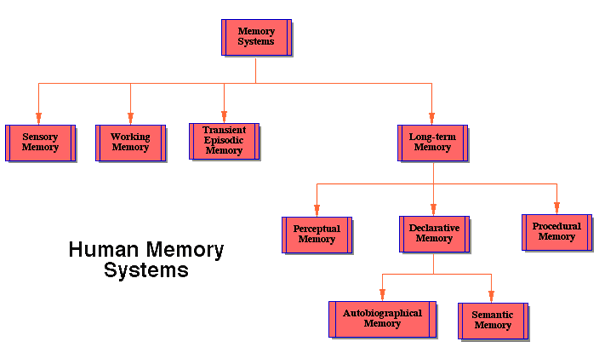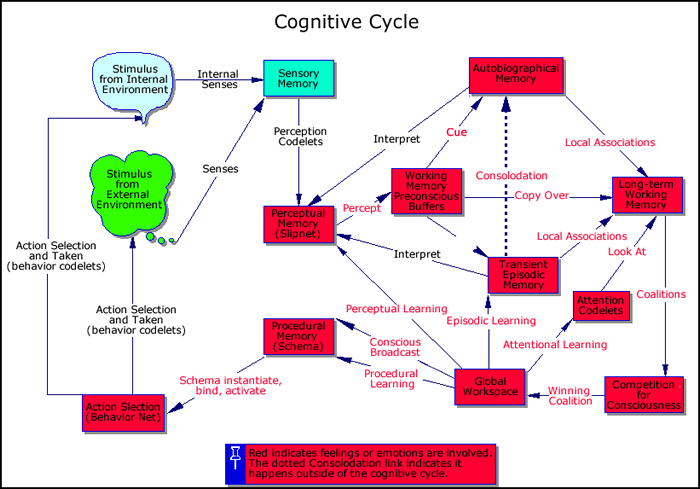AssociativeMemoryResearch
From aHuman Wiki
Revision as of 01:17, 16 June 2015 by Admin (Talk | contribs) (Automated page entry using MWPush.pl)
Associative Memory Research
@@Home -> ArtificialIntelligenceResearch -> AssociativeMemoryResearch

Associative Memory (AM) research covers technologies enabling implementation of associative memory which enables thought process and links previous experience to novel situations.
Contents
Technologies
- Kohonen networks
Types of Associations
Feel the difference between:
- Clear concept can be restored from noisy data
- Most related concept can be restored by its small part
- Several concepts can be derived from feature/another concept
Thoughts
- Pribram's model*
- alternative to the transcortical model of neocortical organization
* extrinsic sectors (primary projection areas) - neocortical areas whose fibers enter or leave the cerebral hemispheres * intrinsic sectors (association areas) - their fibers remain within the cerebrum
- principal interaction of extrinsic and intrinsic systems occurs at the thalamic level
* contribution of intrinsic neocortex to the final output of the extrinsic system is mediated by the convergence of influences from both intrinsic and extrinsic systems by subcortical mechanisms * intrinsic system may influence also the input of the extrinsic systems by regulation of peripheral sensory mechanisms
Interesting Pictures
- Human Memory Systems - see [[1]]

- Cognitive Cycle - see [[2]]

- Generic Auto-Associative Memory - see [[3]]

- Context Binding - see [[4]]

Articles Review
Multi-Associative Memory in fLIF Cell Assemblies (CA)
see [[5]].
- Based on:*
- Hebbs Cell Assembly Theory (CA is neural basis for concepts)
- network of biologically plausible fLIF (fatiguing, Leaky, Integrate and Fire) neurons
- Introduction, Background:*
- hypo: Concepts are stored as CAs, associations are connections between CAs
- concepts connected as 1-1,1-N,N-M
- associations can be context-sensitive - retrieval of an associated concept can be based on a combination of the base concept and the context
- AM features: priming, differential associations, timing, gradual learning and change, encoding instances (and others)
- CAs and auto-associative memory*:
- CA theory: objects, ideas, stimuli and even abstract concepts are represented in the brain by simultaneous activation of large groups of neurons with high mutual synaptic strengths
- *long-term memory*: neurons are learned by Hebbian rule from mutual activation, gradually assembling into CAs after repeated and persistent activation
- *short-term memory:* CA is activated when its certain number of neurons is activated, then CA reverberates due to high mutual synaptic strengths
- CA is a form of auto-associative memory
- *Hopfield Model*: binary neurons, well-connected network, bidirectional weighted connections, Hebbian learning
- CAs and multi-associative memory*:
- Psychologically, memories are not stored as individual concepts, but large collections of associated concepts that have many to many connections
- repeated co-activation of multiple CAs result in the formation of multiple and sequential associations, and sometimes new CAs
- Multi-associative memory models*:
- *Non-Holographic Associative Memory* (1969): well-connected network that can learn to map input bit patterns to output bit patterns; input CAs are connected to output CAs via learned one way associations
- *The Linear Associator* (Kohonen, 1977): feed-forward, well connected network;
- *Multi Modular Associative Memory* (1999): well connected modules, resilient to corrupted input
- *Valiant model* (2005): random graphs, biologically implausible learning, theoretical model of memorisation and association based on four quantitative parameters associated with the cortex:
* the number of neurons per concept * number of synapses per neuron * synaptic strengths * number of neurons in total
- *Interactive activation model* (1981): each concept is represented by a node, and connections are made between nodes to show how closely related these are; not well connected
- Finally:
* simulated neural systems can encode multi-associative memories * well connected systems are not a good model of the brain * use partitioning the system into modules, and sparsely connected random graphs * there models do not account for some human characteristics, e.g. context effects
- Computation model for simulation*:
- fLIF neural network:
- fLIF neurons collect activation from pre-synaptic neurons and fire on surpassing a threshold T - on firing, a neuron loses its activation level, otherwise the activation leaks gradually: Ait = Ait-1/d + Sum( Wij * Sj ). d - decay factor. - firing is a binary event, and activation of Wij is sent to all neurons j to which the firing neuron i has a connection. - fatiguing causes the threshold to be dynamic: t+1 = Tt + Ft. - Ft is positive (F+) if the neuron fires at t and negative (F-) otherwise
- Network architecture:
- network is a whole or split into several subnetworks (for some simulations) - intra-subnet synapses are biologically inspired distance biased connections (most likely excitatory connections to neighbouring neurons) - subnet is a rectangular array of neurons with distance organized toroidally - inhibitory connections within a subnet and all inter-subnet connections are set up randomly - connectivity rule for excitatory neurons; connection i->j exists if Cij=1: Cij = 1; if r < 1/(d*v) r - random between 0 and 1 d - the neuronal distance (value=5 works well for all simulations) v - the connection probability - long distance intra-network connections are inspired by biological long distance axons with many synapses - networks are divided into multiple CAs in response to stimuli using unsupervised learning algorithms - the CAs are orthogonal and represent different concepts, and this is based on training